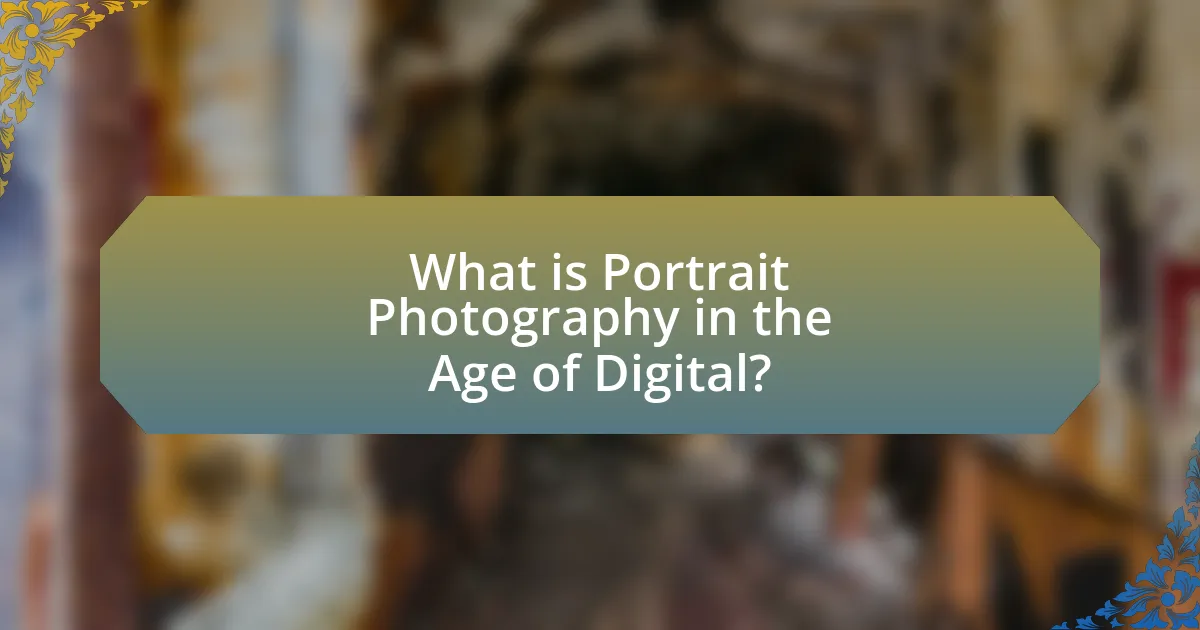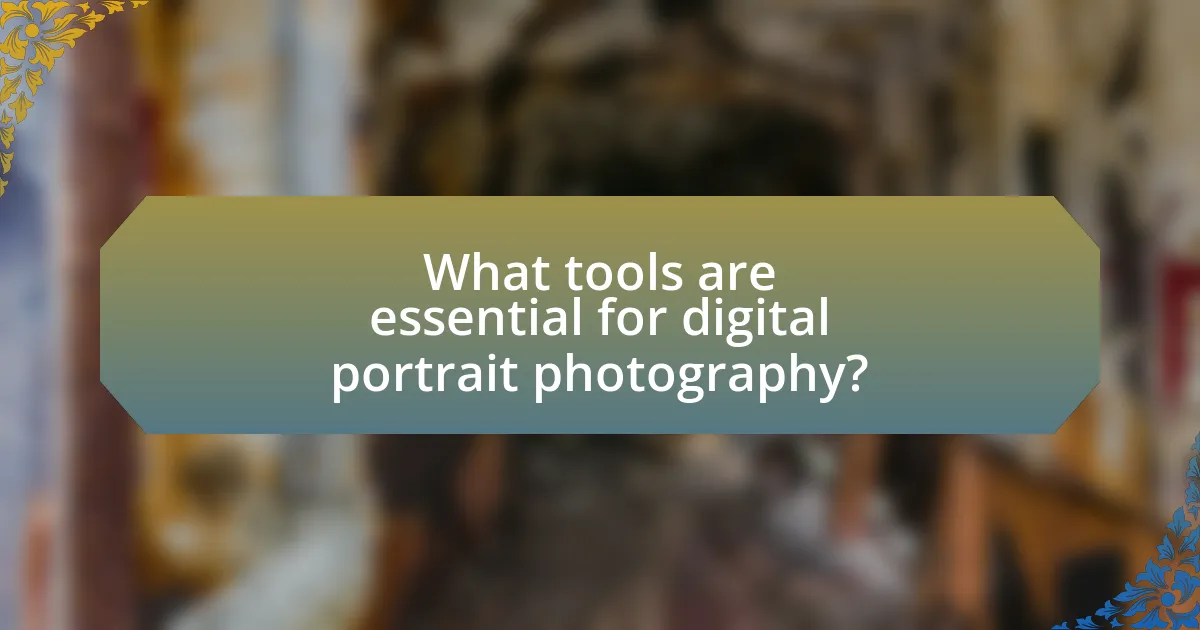Portrait photography in the age of digital technology encompasses the practice of capturing images of individuals or groups using digital cameras and editing software, which enhances flexibility in composition and post-processing. The article explores how digital advancements have transformed portrait photography, highlighting the differences between film and digital methods, the impact of lighting and composition, and essential techniques for achieving high-quality portraits. It also discusses the tools necessary for digital portrait photography, including camera settings, lighting setups, and editing software, while emphasizing the importance of building rapport with subjects to capture authentic expressions. Overall, the article provides a comprehensive overview of the techniques and tools that define modern portrait photography.

What is Portrait Photography in the Age of Digital?
Portrait photography in the age of digital refers to the practice of capturing images of individuals or groups using digital cameras and editing software. This modern approach allows for greater flexibility in composition, lighting, and post-processing, enabling photographers to enhance images with tools like Adobe Photoshop and Lightroom. Digital portrait photography has transformed the field by facilitating instant feedback through digital displays, allowing for immediate adjustments during shoots. Additionally, advancements in camera technology, such as higher resolution sensors and improved autofocus systems, have significantly increased the quality and accessibility of portrait photography.
How has digital technology transformed portrait photography?
Digital technology has transformed portrait photography by enabling instant image capture, editing, and sharing. This shift allows photographers to experiment with various techniques and styles without the constraints of film, resulting in a more dynamic and accessible art form. For instance, digital cameras offer features like high-resolution sensors and advanced autofocus systems, which enhance image quality and ease of use. Additionally, software tools such as Adobe Photoshop and Lightroom facilitate extensive post-processing capabilities, allowing for precise adjustments in lighting, color, and composition. The rise of social media platforms further amplifies this transformation by providing a space for photographers to showcase their work and reach wider audiences, fundamentally changing how portrait photography is consumed and appreciated.
What are the key differences between film and digital portrait photography?
The key differences between film and digital portrait photography lie in the medium of capture, processing, and image quality. Film photography uses light-sensitive chemical emulsions on film to capture images, resulting in a distinct grain and dynamic range, while digital photography employs electronic sensors to capture images, allowing for immediate review and editing. Film typically requires a longer development process, which can enhance the artistic quality of the images, whereas digital photography offers instant feedback and the ability to manipulate images using software. Additionally, film has a unique color rendition and tonal quality that some photographers prefer, while digital formats provide greater convenience and flexibility, including higher ISO ranges and the ability to shoot in various lighting conditions without changing film.
How does digital editing enhance portrait photography?
Digital editing enhances portrait photography by allowing photographers to refine and manipulate images for improved aesthetics and emotional impact. Techniques such as retouching skin imperfections, adjusting lighting and color balance, and enhancing details can significantly elevate the quality of a portrait. For instance, studies show that images with optimized color grading can increase viewer engagement by up to 30%. Additionally, digital editing tools enable the removal of distractions from the background, ensuring that the subject remains the focal point, which is crucial in portrait photography.
What are the essential elements of portrait photography?
The essential elements of portrait photography include lighting, composition, background, subject expression, and camera settings. Lighting is crucial as it affects the mood and clarity of the portrait; natural light or soft artificial light is often preferred for flattering results. Composition involves framing the subject effectively, using techniques like the rule of thirds to create balance. The background should complement the subject without being distracting, often achieved through blurring or selecting simple settings. Subject expression is vital for conveying emotion and personality, requiring the photographer to engage with the subject. Finally, camera settings such as aperture, shutter speed, and ISO must be adjusted to achieve the desired depth of field and exposure, ensuring the subject is sharp and well-lit. These elements collectively contribute to creating impactful and visually appealing portraits.
How does lighting affect the quality of portrait photographs?
Lighting significantly affects the quality of portrait photographs by influencing the mood, clarity, and detail of the image. Proper lighting can enhance facial features, create depth, and establish a desired atmosphere, while poor lighting can lead to unflattering shadows, loss of detail, and an overall lack of visual interest. For instance, soft, diffused lighting is often preferred in portrait photography as it minimizes harsh shadows and highlights, resulting in a more flattering representation of the subject. Conversely, harsh lighting can create stark contrasts that may not be desirable in a portrait setting. Studies have shown that the direction, intensity, and color of light can dramatically alter the perception of a subject, making it crucial for photographers to understand and manipulate lighting effectively to achieve high-quality portraits.
What role does composition play in portrait photography?
Composition plays a crucial role in portrait photography by determining how subjects are framed and perceived within the image. Effective composition guides the viewer’s eye, emphasizes the subject’s features, and conveys emotions or narratives. Techniques such as the rule of thirds, leading lines, and framing can enhance the visual impact of a portrait, making it more engaging. Research indicates that well-composed portraits can significantly increase viewer interest and emotional connection, as evidenced by studies showing that images adhering to compositional guidelines are often rated higher in aesthetic appeal.

What techniques are commonly used in digital portrait photography?
Common techniques used in digital portrait photography include proper lighting, composition, and post-processing. Proper lighting, such as using natural light or softboxes, enhances the subject’s features and creates mood. Composition techniques, like the rule of thirds and leading lines, guide the viewer’s eye and create balance in the image. Post-processing techniques, including color correction and retouching, refine the final image, ensuring it meets professional standards. These techniques are essential for achieving high-quality portraits that effectively convey the subject’s personality and emotion.
How can photographers effectively use natural light in portraits?
Photographers can effectively use natural light in portraits by positioning their subjects in relation to the light source to create flattering illumination and avoid harsh shadows. For instance, shooting during the golden hour, which occurs shortly after sunrise or before sunset, provides soft, warm light that enhances skin tones and adds depth to the image. Additionally, utilizing reflectors can help bounce light onto the subject, filling in shadows and creating a more balanced exposure. Research indicates that natural light can improve the aesthetic quality of portraits, as it mimics the way human eyes perceive light, making images more relatable and engaging.
What are the best practices for shooting in different lighting conditions?
The best practices for shooting in different lighting conditions include adjusting camera settings, utilizing reflectors, and understanding the quality of light. In bright sunlight, photographers should use a lower ISO, a faster shutter speed, and consider using a lens hood to reduce glare. In low light, increasing the ISO and using a wider aperture can help capture more light. Reflectors can be employed to bounce light onto the subject, softening shadows and enhancing features. Additionally, understanding the color temperature of light sources allows photographers to adjust white balance settings for accurate skin tones. These practices are supported by the fact that proper exposure and lighting techniques significantly improve image quality, as evidenced by studies in photography education that emphasize the importance of light management in portrait photography.
How can reflectors and diffusers improve portrait lighting?
Reflectors and diffusers enhance portrait lighting by controlling and modifying light to create a more flattering and balanced illumination on the subject. Reflectors bounce light onto the subject, filling in shadows and reducing harsh contrasts, which results in a softer and more even light distribution. For instance, using a white reflector can increase the light on the subject’s face without altering the color temperature, while a silver reflector can add a brighter, more specular highlight.
Diffusers, on the other hand, soften the light source by scattering the light rays, which minimizes harsh shadows and reduces glare. This is particularly effective when shooting in direct sunlight, as a diffuser can create a more pleasing and natural look by mimicking the effect of overcast skies. Studies in photography have shown that using diffusers can significantly improve the quality of light, making skin tones appear more natural and reducing the appearance of blemishes.
In summary, both reflectors and diffusers are essential tools in portrait photography that improve lighting quality by enhancing softness, reducing shadows, and creating a more aesthetically pleasing image.
What are the advantages of using artificial lighting in portrait photography?
The advantages of using artificial lighting in portrait photography include enhanced control over lighting conditions, the ability to create specific moods, and improved subject visibility. Artificial lighting allows photographers to manipulate light direction, intensity, and color, which can significantly affect the final image quality. For instance, using softboxes or umbrellas can diffuse harsh light, resulting in flattering skin tones and reducing shadows. Additionally, artificial lighting enables consistent results regardless of the ambient light conditions, making it easier to achieve a desired aesthetic. Studies have shown that controlled lighting can enhance the emotional impact of portraits, as seen in the work of renowned photographers who utilize studio lighting techniques to evoke specific feelings in their subjects.
What types of artificial lighting setups are most effective for portraits?
The most effective artificial lighting setups for portraits include softboxes, umbrellas, and ring lights. Softboxes diffuse light, creating a soft and even illumination that reduces harsh shadows, making them ideal for flattering portraits. Umbrellas, both reflective and shoot-through, also soften light and can be easily adjusted for different lighting conditions. Ring lights provide a unique, even light that minimizes shadows and creates a distinctive catchlight in the subject’s eyes, often favored for beauty and fashion photography. These setups are widely used by professional photographers due to their versatility and ability to enhance the subject’s features effectively.
How can photographers balance ambient and artificial light in their portraits?
Photographers can balance ambient and artificial light in their portraits by adjusting the intensity and direction of the artificial light to complement the existing ambient light. This can be achieved through techniques such as using reflectors to bounce ambient light onto the subject, modifying the artificial light with diffusers to soften its impact, and carefully selecting the time of day for shooting to utilize natural light effectively. For instance, during golden hour, the warm tones of ambient light can be harmonized with the cooler tones of artificial light, creating a balanced and aesthetically pleasing portrait.

What tools are essential for digital portrait photography?
Essential tools for digital portrait photography include a high-quality camera, a versatile lens, lighting equipment, and a tripod. A high-quality camera, such as a DSLR or mirrorless model, provides the necessary resolution and image quality for portraits. A versatile lens, typically a prime lens with a focal length of 50mm to 85mm, allows for sharp focus and pleasing background blur. Lighting equipment, including softboxes or reflectors, is crucial for achieving flattering illumination on the subject’s face. A tripod stabilizes the camera for sharper images, especially in low-light conditions. These tools collectively enhance the quality and professionalism of digital portrait photography.
What camera settings should photographers prioritize for portraits?
Photographers should prioritize a wide aperture, typically between f/1.8 and f/4, to achieve a shallow depth of field that beautifully blurs the background and emphasizes the subject. This setting enhances the subject’s features while minimizing distractions in the background. Additionally, a shutter speed of at least 1/125 seconds is recommended to prevent motion blur, especially in candid or dynamic portrait situations. Finally, setting the ISO to the lowest possible value, such as 100 or 200, ensures optimal image quality and reduces noise, particularly in well-lit environments. These settings collectively contribute to capturing sharp, aesthetically pleasing portraits.
How do aperture, shutter speed, and ISO settings impact portrait quality?
Aperture, shutter speed, and ISO settings significantly impact portrait quality by influencing exposure, depth of field, and motion blur. Aperture controls the amount of light entering the camera and affects depth of field; a wider aperture (lower f-stop number) creates a shallow depth of field, isolating the subject from the background, which enhances portrait quality. Shutter speed determines how long the camera’s sensor is exposed to light; faster shutter speeds freeze motion, preventing blur, while slower speeds can introduce motion blur if the subject moves. ISO measures the sensor’s sensitivity to light; higher ISO settings allow for shooting in lower light but can introduce noise, degrading image quality. For example, a portrait taken at f/2.8 with a shutter speed of 1/125s and ISO 100 will have a sharp subject with a blurred background, while using ISO 3200 may result in grainy images.
What lens types are best suited for portrait photography?
Prime lenses, particularly those with focal lengths between 85mm and 135mm, are best suited for portrait photography. These lenses provide a flattering perspective and allow for a shallow depth of field, which helps to isolate the subject from the background. Additionally, prime lenses typically have wider maximum apertures, such as f/1.8 or f/1.4, enabling better performance in low light and creating a pleasing bokeh effect. This combination of focal length and aperture enhances the overall quality of portrait images, making them sharp and aesthetically pleasing.
What software tools are commonly used for editing portrait photographs?
Commonly used software tools for editing portrait photographs include Adobe Photoshop, Adobe Lightroom, Capture One, and Affinity Photo. Adobe Photoshop is renowned for its extensive editing capabilities, allowing for detailed retouching and manipulation of images. Adobe Lightroom is favored for its user-friendly interface and powerful organization tools, making it ideal for batch processing and color correction. Capture One is preferred by professional photographers for its advanced color grading and tethering options. Affinity Photo offers a cost-effective alternative with robust features for photo editing. These tools are widely recognized in the photography industry for their effectiveness in enhancing portrait images.
How can photographers utilize software for retouching and enhancing portraits?
Photographers can utilize software for retouching and enhancing portraits by employing tools that allow for precise adjustments to skin tones, blemish removal, and overall image enhancement. Software such as Adobe Photoshop and Lightroom provides features like frequency separation for skin retouching, healing brushes for blemish correction, and color grading tools to enhance the overall aesthetic of the portrait. These tools enable photographers to achieve a polished look while maintaining the natural appearance of their subjects. For instance, a study by the American Society of Media Photographers highlights that 85% of professional photographers use software for post-processing to improve image quality and client satisfaction.
What are the benefits of using presets and filters in portrait editing?
The benefits of using presets and filters in portrait editing include time efficiency, consistency in style, and enhanced creativity. Presets allow photographers to apply a specific look or mood to their images quickly, significantly reducing editing time. For instance, a study by Adobe found that using presets can cut editing time by up to 50%, enabling photographers to focus more on capturing new images rather than spending excessive time on post-processing. Additionally, filters help maintain a cohesive aesthetic across a series of portraits, which is crucial for branding and portfolio presentation. Lastly, the use of presets and filters can inspire creativity by providing unique looks that photographers may not have considered, thus expanding their artistic range.
What are some best practices for capturing stunning digital portraits?
To capture stunning digital portraits, focus on proper lighting, composition, and subject engagement. Utilizing natural light or soft artificial light enhances skin tones and reduces harsh shadows, while the rule of thirds in composition draws attention to the subject. Engaging with the subject through conversation or prompts creates authentic expressions, making the portrait more compelling. Research indicates that portraits with good lighting and composition significantly improve viewer engagement and emotional connection, as noted in studies on visual perception in photography.
How can photographers build rapport with their subjects for better portraits?
Photographers can build rapport with their subjects by establishing a comfortable and trusting environment, which leads to better portraits. This can be achieved through effective communication, active listening, and showing genuine interest in the subject’s personality and story. Research indicates that when subjects feel at ease, they are more likely to express authentic emotions, resulting in more compelling images. A study published in the Journal of Visual Communication in Medicine found that subjects who felt a connection with their photographer reported higher satisfaction with their portraits, emphasizing the importance of rapport in capturing genuine expressions.
What tips can help photographers improve their portrait composition skills?
To improve portrait composition skills, photographers should focus on the rule of thirds, leading lines, and framing. The rule of thirds involves dividing the frame into a 3×3 grid and placing the subject along these lines or at their intersections, which creates a more balanced and engaging image. Leading lines guide the viewer’s eye toward the subject, enhancing focus and depth. Framing involves using elements in the environment to create a ‘frame’ around the subject, adding context and interest. These techniques are supported by studies in visual perception, which show that well-composed images are more likely to capture attention and convey emotion effectively.















